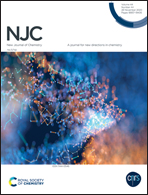Facile design of a dextran derived polyurethane hydrogel and metallopolymer: a sustainable approach for elimination of organic dyes and reduction of nitrophenols†
Abstract
This work reports a sustainable approach for fabrication of a highly cost-effective and operation-convenient adsorbent derived from dextran and its valorization to a metallopolymer photocatalyst. The hydrogel with a significant magnitude of equilibrium water absorbency (EWA) was prepared by crosslinking with hexamethylene diisocyanate in a simple one pot synthesis. Due to numerous functionalities, the hydrogel not only adsorbs cationic and anionic dyes but also efficiently scavenges heavy and valuable metal ions from effluents. The removal efficiency of dyes (concentration 100 mg L−1) is greater than 80% in the presence of 100 mg of adsorbent. The adsorption process and its probable mechanism are supported by both experimental (via appropriate analytical characterization) and theoretical (kinetic modelling and thermodynamic calculations) evidence. The recovery of heavy metals was demonstrated with silver ions, which were further readily reduced to silver nanoparticles to generate a metallopolymer photocatalyst. The latter catalyzes complete reduction of nitrophenol within 10 seconds in the presence of sunlight. A process flow diagram for commercial scale up and production of an economically viable adsorbent for effluent treatment using waste from the sugar industry and its valorization as a photocatalyst is reported for the first time.



 Please wait while we load your content...
Please wait while we load your content...